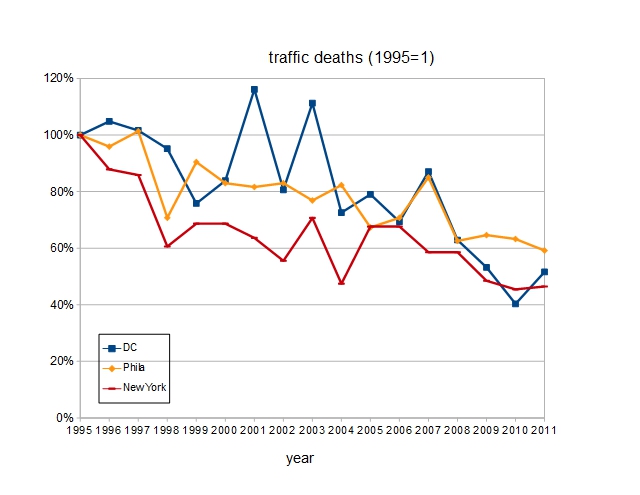The Metropolitan Police Department would have you think so, arguing that the rate of decline of traffic deaths in the District is greater than that observed nationwide (down 32%, 1995 to 2011), and the difference must be due to whatever the District is doing, namely “photo enforcement”. But that's a comparison of a wholly urbanized DC to the suburbs and open highways of the United States, and is as wrong as any attempt to compare the statistics of our city to any state. The nationwide decline in traffic fatalities is surely due primarily to safer cars (air bags, anti-lock brakes, etc.), and the safety measures mandated for cars since the early 1990s are likely to be more effective at the low speeds of the city than at the high speeds of the interstates, and rural highways.
Numerous studies of speed cameras have suggested that they do indeed save lives, though investigators complain about the poor quality of the data provided. Invariably one sees only before-and-after comparisons, with no good control situation for comparison of simultaneous results. But in fact we do have controls of some plausible validity for the District, namely cities in which there are no speed cameras. New York City, and Philadelphia, have none, due to state government restrictions. So safer-car effects should be operative there, but not speed cameras, and perhaps we can learn something from the comparison. (There are always differences, so this cannot be a definitive comparison, merely suggestive.)
NHTSA (the National Highway Traffic Safety Administration) has traffic fatality data for counties and states going back to 1995, through 2011. The District, of course, counts as a “county”. New York County is Manhattan, which is surely more “urbanized” than the District, something to keep in mind for a comparison. Philadelphia County is coterminous with Philadelphia city, and might be a better model for DC. Well, with those caveats in mind, let's do the comparison:

Of course, the District is fond of taking 2001 as its starting point. But clearly that is an anomalous year, deviating substantially from the overall trend. No doubt taking 2001 as a reference point will make any later-year numbers look very good. That's called “cherry-picking” one's data to get a preferred result.
This is not to say that speed cameras have no role. I've worked long and hard to get one in my neighborhood, responding to residents' complaints about excessive traffic speed. But the point is simply to make city life a bit more comfortable, a bit less threatening, for residents, worrying about their children and their pets as traffic rushes by their homes. That's a valid goal. There's no need to gild the lily by asserting that speed cameras save lives. Here in the city, there's little evidence that they do.